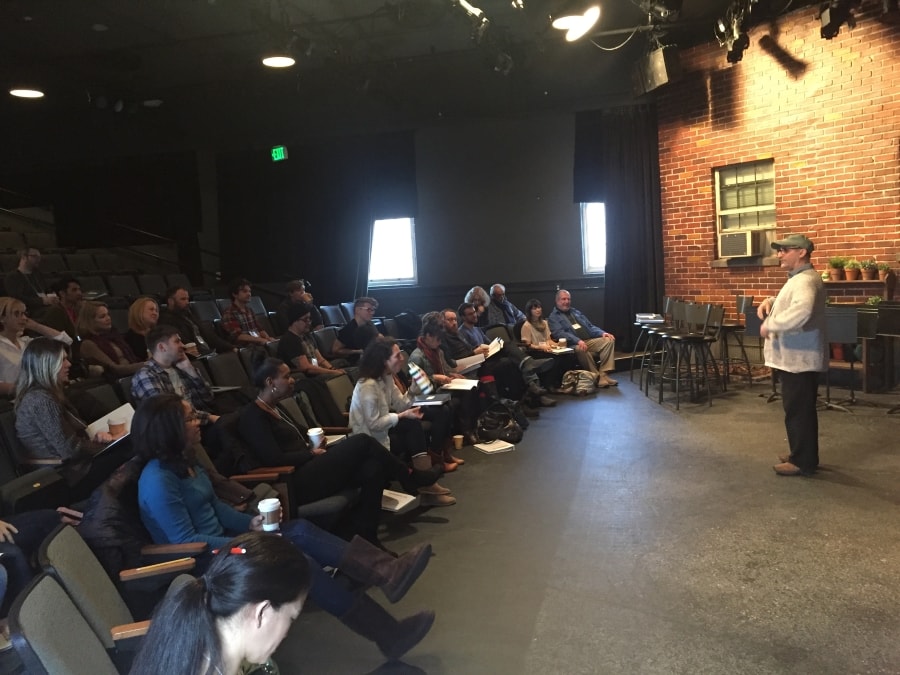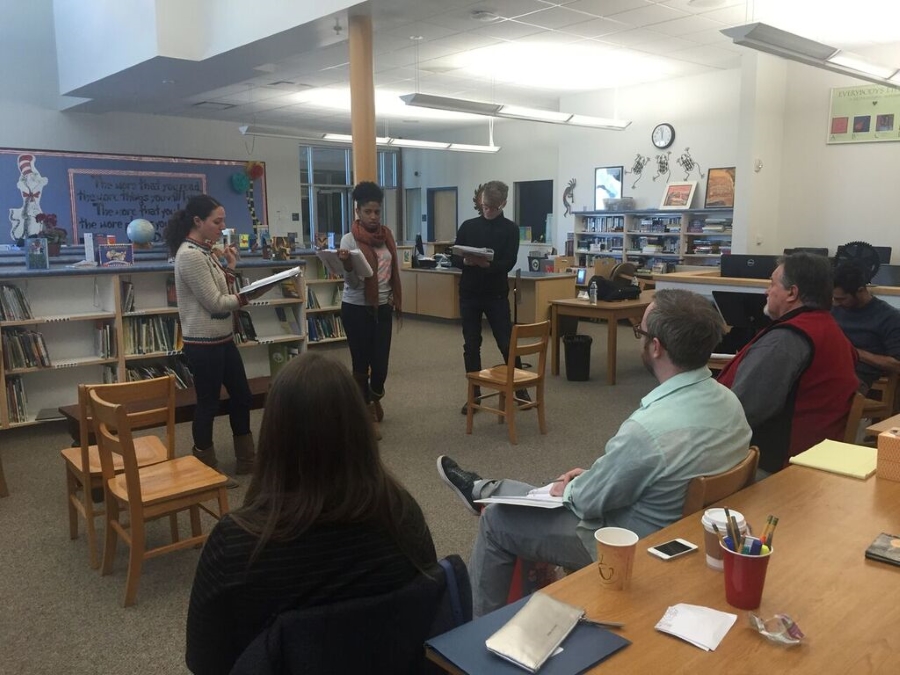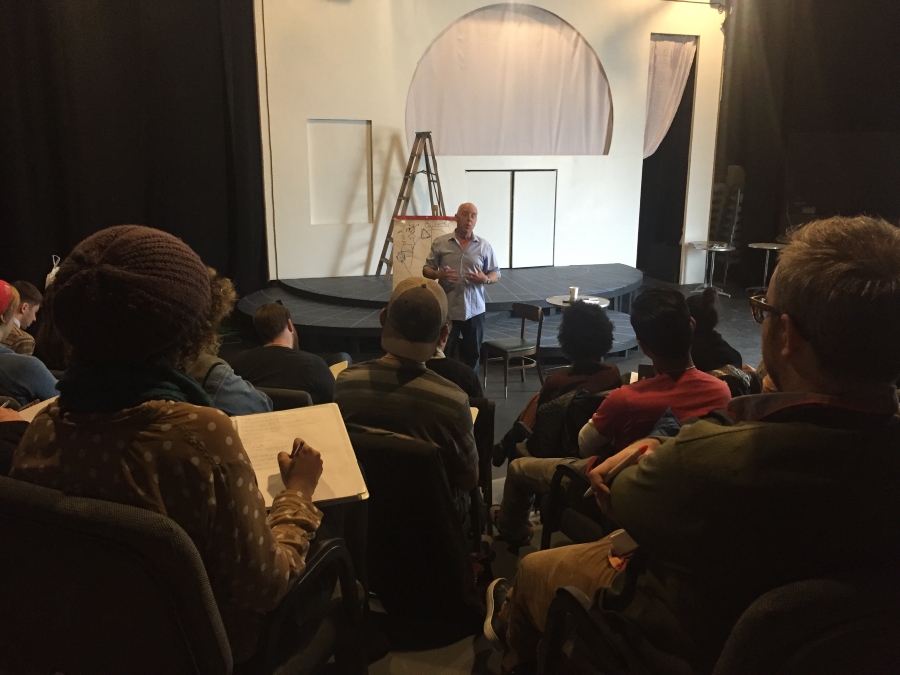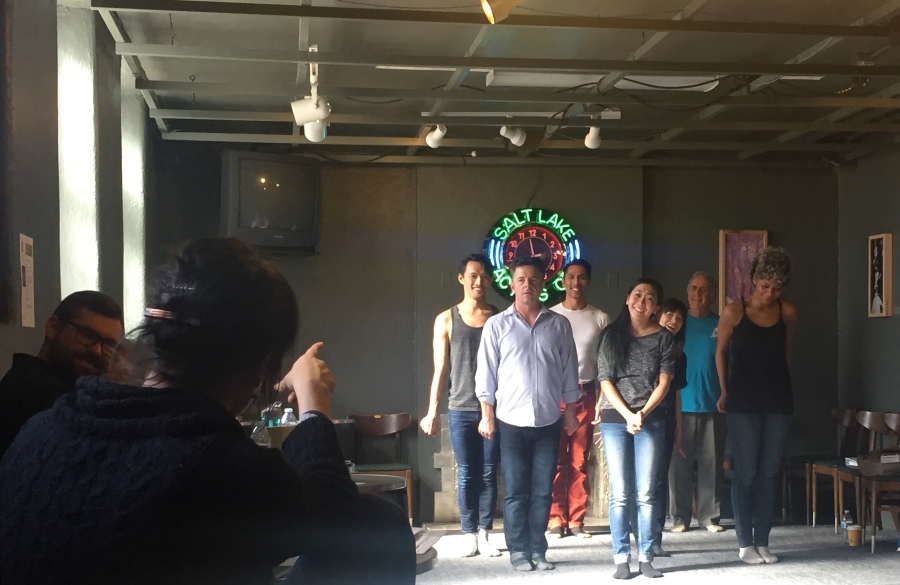SALT LAKE CITY: It was a sunny day, though the backdrop of snow-capped mountains seemingly belied the morning warmth. A group of playwrights, directors, actors, and dramaturgs sang along to a ukulele outside of Salt Lake Acting Company (SLAC)—the final warmup of the weeklong Playwrights’ Lab at the theatre.
The lab’s leader was playwright David Kranes, former artistic director of the Sundance Theatre Lab (then known as the Sundance Institute). SLAC had produced seven of Kranes’s plays, and they approached him about building a Sundance-style program at the theatre. “They promised to find the means to support it and were clearly and genuinely thrilled about the notion,” Kranes said. “It was a request I couldn’t say no to.”
Now in its second year, the lab gives writers the space and time to develop new work. And unlike in other new-play development programs, there is no pressure to present a final reading or performance.
“My hope is that during the days of the lab, the writer is able—in ways she or he has never contemplated—to explore the greater range and possibilities of his or her instrument/voice/gifts,” Kranes explained. “Such exploration won’t happen when the curtain goes up at 7:30 p.m. next Wednesday night.”

The program, in short, is structured with a lot of “playtime”: Writers have the freedom to see the work on its feet and bounce ideas around with the help of a director, dramaturg, and actors. The 2016 lab brought 46 artists from Salt Lake City and around the country to the theatre, and playwrights Troy Deutsch, David Jacobi, Hansol Jung, and Kate Tarker were at the center of the action.
Kranes also brings in artists from other fields, called “resource artists,” to expand the playwrights’ development processes. As a writer, Kranes knows inspiration sometimes comes in unlikely forms, and throughout the week, multidisciplinary artists presented work for the playwrights. This year’s lineup included a musicologist, a professional storyteller, a clown, and a choreographer. “It’s bringing in people from all different mediums and expertise that you wouldn’t necessarily think of for play development,” said associate artistic director Shannon Musgrave.
Deutsch found Ricklen Nobis, a musicologist, particularly helpful in working on his play Bull Shark Attack. The work features three characters who each perform monologues, and Deutsch and Nobis worked on the structure like music. “It really informed the conversations with the actors about treating the paragraphs like stanzas, and treating the script like a score,” Deutsch says.

Rehearsal real estate at the theatre was limited, so the team for Jacobi’s Ready Steady Yeti Go worked at the library of a nearby elementary school. The cast sat in too-small chairs—a fitting seating arrangement, as these adult actors play children in the play. In the aftermath of a hate crime, the story follows a budding romance between Goon and Carly, the school’s only black student.
In a nearby classroom, the cast of Bull Shark Attack explored the physicality of floating in water and walking on sand. Written by Deutsch, the play is about three loners who all end up on the beach one fateful night. Charlotte Boye-Christensen, a choreographer, worked with actor April Fossen, who stood on a stool, on how to move her body to simulate swimming. Then, dramaturg Patrick Tovatt noted that the water in a sound would not crash, but instead would gently lap. Deutsch made a line note.
The cast of Tarker’s Laura and the Sea was working on choreography to fill three minutes of silence in the script. The dark comedy is about employees at a travel agency trying to cope with the loss of a coworker who took her own life during a company outing. Director Michael Rau instructed the room to compose a silent scene which would include a moment of surprise, a gesture of comfort, 10 seconds of a movement in unison, a discovery of extraordinary beauty, and the feeling of weightlessness. He left the room, and the cast rushed to build the scene in only three minutes. When he returned, the actors performed their composition, and Rau paused, imagining what the lighting might be, then said, “We’ll come back to that in tech!” Everyone laughed.

While there is no tech and no official final presentation, all the artists gathered to share their work with each other before they left Salt Lake.
Jung, who had to leave a few days early to mount her new play Cardboard Piano at the Humana Festival at Actors Theatre of Louisville, was there in spirit. The cast of her play Wild Goose Dreams presented a Korean pop song. The story follows a “goose father” from South Korea, supporting his wife and daughter who have moved to America. When his girlfriend leaves him too, he makes a video of himself singing a K-Pop song, and it goes viral. The other groups presented their favorite scenes and demonstrated their methods of working throughout the week.
Musgrave will take the reins of the lab moving forward, and said she hopes to build in more time for the playwrights to write and make more time for participants to explore the city. When she asked this year’s participants what they wanted to see in the lab next year, a voice shouted, “I hope you continue to bring people from all around the country.”
Another piped in, “Next year, I hope you keep the variety of the voices of the playwrights.”


